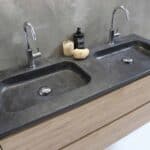This post may contain affiliate links. If you use these links to buy something we may earn a small commission. Thanks.
Delta’s extensive collection of faucets has made them one of the top suppliers, and it is their use of recoiling sprayer hoses that separates them from their competitors.
However, the sprayer hose is often the cause of complications such as leakages and may need to be disconnected to allow for a replacement.
If you’re wondering how to disconnect a sprayer hose from a Delta faucet, we’ve got your covered.
In this article, we’ll provide you with a step-by-step guide to the disconnection process, saving you the hassle and expense of hiring a professional plumber.
You can save yourself a considerable amount of time and money doing it yourself.
How Does the Faucet Sprayer System Work?
Before you can successfully carry out the procedure, you must first be able to understand the connection between the faucet and sprayer hose, in other words, how the faucet sprayer system works.
It is important to note that most faucets are sold with the sprayer directly attached, and the sprayer functions using both water pressure and the force of gravity. The parts aren’t visible – they’re concealed under the sink or hose body.
You will find the sprayer’s working end located within the hose. The water enters the sprayer hose from underneath after flowing through the faucet. A diverter is contained within the hose’s base; this is a plastic collar that sits inside the hose when you switch on the faucet controls.
Releasing the sprayer trigger means that the water supply to the sprayer head cannot exit the spout, causing the collar to rise in line with the reverse flow. To allow the sprayer to work, the faucet needs to be opened – keep in mind that the spout can be shut by the pressure from the water flow changing direction.
What Type of Delta Kitchen Faucets Have a Sprayer Hose?
Having gained a deeper understanding of the faucet-sprayer hose relationship, you should now be able to disconnect the sprayer head with ease. However, before you can begin the procedure of detaching the sprayer head, it is important to identify the style of faucet you are working with.
The kitchen style of Delta faucet is available in three main types, each of which comes equipped with a sprayer hose. It is important to note which type of Delta kitchen faucet you have, as this knowledge will help you when it comes to carrying out the procedure.
Two-Handled Center Set Model
- It can be identified by its distinguishing set of two handles.
- Has faucet and shut-off controls positioned along the sink.
- The veggie sprayer can also be found along the same line as the faucet and valves.
Widespread Kitchen Faucet
- Is recognized by its single handle.
- Unlike the center set kitchen faucet, it features a separate veggie sprayer.
Single-Handle Pull-Out Kitchen Faucet
- Comes with only one handle.
- The difference here is that the faucet spout and veggie sprayer head are connected.
Identifying the style of the faucet is the first step to a successful procedure. If you have never attempted to disconnect the sprayer hose before, familiarizing yourself with the model is a good place to start.
Tools You’ll Need to Disconnect the Sprayer Hose
Disconnecting the sprayer hose may seem like a daunting task at first, but in fact, it is relatively straightforward if you know the right tools to use. It is recommended that you collect all tools before you start; that way, you’ll have them all to hand for whenever you may need them.
All tools and replacement parts can be found at the hardware store, although it is always worth checking if you have them already before making a purchase. The same tools are used by professional plumbers when carrying out the procedure, but completing the task yourself could save you a considerable amount of money.
You’ll need a new spray head and sprayer hose to replace the faulty parts, as well as an adjustable wrench to help you loosen the sprayer hose nuts. A basin wrench may also be necessary if the design of your sink requires it.
It is also essential to have a pair of pliers to hand, as these will come in useful when tightening the stem connection. A screwdriver will assist you with the removal of the spray head, while a pocketknife can be used to help you detach the C-clip.
In order to successfully carry out the procedure, you’ll need to be able to see what you are doing underneath the sink. That’s why a flashlight is an essential tool in this process, allowing you to focus all your attention on the task at hand.
You’ll need:
- a new spray head and sprayer hose to replace the faulty parts
- an adjustable wrench to help you loosen the sprayer hose nuts
- a basin wrench, if the design of your sink requires it
- a pair of pliers; these will come in useful when tightening the stem connection
- a screwdriver to assist with the removal of the spray head
- a pocketknife to help you detach the C-clip.
- a flashlight to help you see under the sink.
Steps to Disconnect a Sprayer Hose from a Delta Faucet
1. Turn off the water supply lines and drain the water
Switch off the water valve controls to shut off the water supply. Not only is it impossible to carry out the task while the valves are turned on, but it is also extremely impractical as you will find yourself covered in water.
Drain any water residue from the interior of both the outlet tube and the sprayer hose. This can be done by running the sprayer, making it easier to loosen the nuts. Position a bucket below the sprayer hose to catch any drips that fall while you are working.
2. Loosen the nuts and detach the hose
Identify the outlet tube underneath the sink unit and find the connecting sprayer hose. If you happen to find a clip that connects the hose and tube, you will need to detach it and store it away.
Position a bucket to allow water from the hose to drain and loosen the nuts. Use the adjustable wrench to complete this step and move it counter-clockwise, doing so until the nuts are loosened and you can detach them by hand. If required, you should use loosen the nuts with a basin wrench for a threaded connection.
Having loosened the nuts, you can now disconnect the sprayer hose from the Delta faucet. Simply loosen the deck fitting nut with a screwdriver and pull it off from the opposite side.
3. Remove the sprayer head
Rotate the slide nut anti-clockwise and the sprayer head will detach from the hose.
You may find that an older spray head will have a build-up of mineral deposits. If this is the case, water and white vinegar can be mixed to create a cleansing solution. Submerging the head in the solution will make it easier to remove. After this, you can simply detach the spray head and store it nearby for safekeeping.
A pull-out faucet type will require you to curve the sprayer hose after it’s pulled. In the case of an easily detachable connection, the sprayer can be disconnected by pushing a button.
4. Check for leaks and replace any broken parts
Inspect the sprayer hose and head for signs of leaks or faucet corrosion. If you discover leaking from the stem connection, use a basin wrench or pliers to tighten it. However, if the leaking continues, it is recommended that you replace the sprayer hose.
You may be able to request replacement parts if the warranty for your faucet is valid. This can be done by contacting the supplier’s customer care team directly. However, if the warranty has expired, you will need to acquire the parts yourself. Take the broken parts to the hardware store and purchase an identical model.
5. Reassemble the spray head and reconnect it
Now you know how to disconnect the sprayer hose from the Delta faucet, it’s time to put it back together!
Having extracted the sprayer hose assembly and purchased the replacement parts or a new sprayer hose, you can now position the replacement deck fitting where the old one used to be. Use a screwdriver to fix it in place with nuts from under the sink unit, and insert the replacement sprayer hose into the deck fitting.
Carry out the reconnection while wrapping the male threads using pipe tape, and secure the hose in the faucet stem to complete the procedure. By following the right steps using the best tools for the job, you should now be able to disconnect the sprayer hose from your Delta faucet.
Final Thoughts
Now you know how to disconnect the sprayer hose from the Delta faucet, you can give it a go yourself next time you are experiencing problems with your sprayer heads or leaking from the base.
You can’t go wrong by following our guide, but don’t hesitate to get in touch with a plumber if you’re not confident doing the job yourself.


